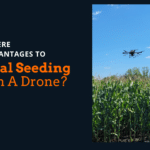Cover crops are a highly effective tool in many farming operations. For farmers that raise livestock in addition to cash crops, further benefit is added to the soil through their use.
Planting Cover Crops As Livestock Forage
A common post harvest tactic with livestock such as cattle is grazing them on harvested ground, such as corn. This allows the cattle to extend the grazing season and their foraging behavior adds natural fertilizer to the soil. While theoretically a great idea, the actual practice of this can be limited.
One of the challenges of making cover crops work as livestock forage, particularly on organic farms, is that planting them is next to impossible once the cash crop has reached a certain height. There are challenges to planting, time constraints, compaction implications, among many other factors that all reduce the viability of planting cover crops.
If using cover crops is something you’ve done or are considering doing, you should also consider the use of a drone to aerial seed cover crops. Recently, Crop Fertility Services has started to offer custom drone seeding in Minnesota and the Upper Midwest, through Brian Halonen of Elevated Ag Solutions. Many of our farmers know Brian as he has handled all of our raw manure sales and spreading operations.
Drone Seeding Cover Crops As Livestock Forage
Drone seeding a cover crop into standing corn provides many advantages to the farmer. Not only will the cover crop have time to get to work fixing Nitrogen in the soil, preventing erosion and suppressing weeds, it’ll add feed value to the area livestock will be grazing upon harvest. Putting a cover crop to use on your farm, especially when used for livestock grazing after harvest, is a great idea and can be a valuable tool when used correctly.
On top of this, there are often cover crop incentive programs that can offset the cost of their use. For more information on what programs may be available in your area, contact Brian at (320)266-8072.
What Cover Crops Look Like When Used For Livestock Forage
Cover crops, when used as livestock forage and planted at the right time, can be very effective. It’s critical that they’re planted at the right time, giving them an opportunity to establish themselves and do exactly what it is they’re designed to do. Up until this point, planting them at the right time has been restricted by the height of the crop itself.
On top of that, wet soil conditions often prevent the farmer from being able to enter the field using traditional planting methods with a tractor. With a drone on the other hand, cover crops can be planted at any time.
The photo below shows a cover crop that was planted with our drone into standing corn, specifically to be used for post harvest cattle grazing.
In this scenario, planting a cover crop into the corn at this height would’ve been impossible without the use of a drone. We were able to successfully broadcast this cover crop into the standing corn and by the time the corn was harvested, it had established itself well. When it comes to aerial seeding a cover crop with a drone, there can be disadvantages (such as an abnormally large rain event), so it is critical that the seeding is timed correctly. While there are some risks, the advantage of aerial seeding cover crops far outweighs simply not using them.
The cattle went on to forage this ground for the remainder of the season, spreading their own manure onto the soil further adding value for the following season.
We offer custom drone seeding here in Minnesota and throughout the Upper Midwest.
For more, contact Brian Halonen of Elevated Ag Solutions at (320)266-8072













